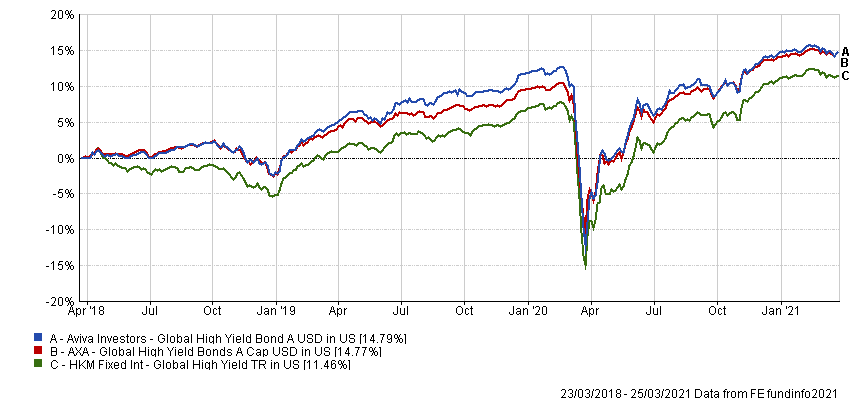The FSA Spy market buzz – 28 March 2025
JP Morgan Asset Management gets enhanced; Thailand wants some leverage; Natxis is surveying the world; A billionaire here, another there; Business social media lunacy; Andrew Carnegie’s wisdom and more.

The three-year cumulative performances of the Axa and Aviva funds are almost identical. They have generated 14.77% and 14.79% respectively, according to FE Fundinfo data. Their returns are significantly better than the global high yield sector average of 11.46%.
The Axa fund “could lag in market selloffs due to its bias in weaker credits, but at the same time is better positioned to rally in periods of sharp spread compression,” said Gkeka.
“On the other hand, its short duration tilt mitigates this bias, as demonstrated by the strategy’s outperformance during the Q1 2020 Covid-selloff,” she said.
Nevertheless, the fund’s structural underweight to lower quality energy sectors and emerging markets could lead to underperformance in periods when investors bid up these sectors – and vice versa, according to Gkeka.
According to Morningstar, the Axa fund’s trailing three-year and five-year standard deviation is 8.6% and 7% respectively, leading to a lower volatility profile compared with its peers and benchmark.
“The strategy’s short duration bias has efficiently mitigated the effect of its bias towards weaker credits, resulting in better downside management than other products in its sector,” said Gkeka.
The Aviva Global High Yield Bond Fund should “perform well in down markets or sideways markets (if security selection works well) because of its conservative profile,” said Gkeka.
“On the flipside, its low exposure to the riskier parts of the high yield market, such as BB- and CCC-rated bonds and emerging market corporate bonds, is likely to lead to underperformance in strong market rallies,” she added.
The Aviva fund’s three-year and five-year standard deviation is 10.3% and 8.2% respectively, which is in line with its peers and benchmark.
“Looking at longer periods, the strategy’s conservative profile has led to lower volatility compared with its peers and high yield market benchmarks, but its higher duration and bigger allocation to energy has resulted in higher volatility than the Axa fund in recent years,” said Gkeka.
Discrete calendar year performance
| Fund/ Sector | YTD* |
2020 |
2019 |
2018 |
2017 |
2016 |
| Aviva |
-0.03% |
2.68% |
14.11% |
-3.08% |
5.64% |
9.85% |
| Axa |
0.56% |
4.20% |
11.98% |
-2.83% |
6.50% |
13.44% |
| Global High Yield sector |
0.27% |
5.43% |
10.84% |
-4.78% |
8.73% |
9.35% |
 Nuveen broadens income sources via private capital and real assets
Nuveen broadens income sources via private capital and real assets
 Investment Ideas for 2021: Explore the untapped potential in China Small Companies
Investment Ideas for 2021: Explore the untapped potential in China Small Companies
 Ninety One: Finding opportunities in times of change
Ninety One: Finding opportunities in times of change
 Don’t get left behind in fixed income
Don’t get left behind in fixed income
 Step up your portfolio by doubling down on sectors set for long-term growth
Step up your portfolio by doubling down on sectors set for long-term growth
 Unmasking the dividend opportunity
Unmasking the dividend opportunity
 Who’s afraid of higher interest rates?
Who’s afraid of higher interest rates?
 Thematic investment series: Innovative transformation cuts across “old” and “new” economy companies
Thematic investment series: Innovative transformation cuts across “old” and “new” economy companies
 Conditions in the high yield market
Conditions in the high yield market
 The future of mobility
The future of mobility

JP Morgan Asset Management gets enhanced; Thailand wants some leverage; Natxis is surveying the world; A billionaire here, another there; Business social media lunacy; Andrew Carnegie’s wisdom and more.
Part of the Mark Allen Group.
